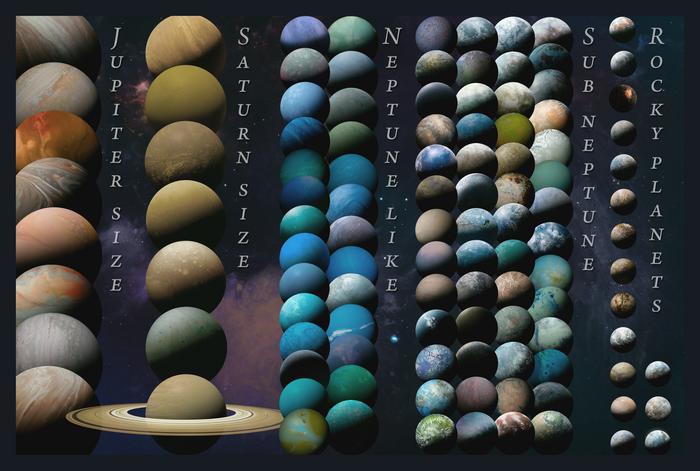An international scientific team, with major contributions by astronomers at the University of Hawaiʻi Institute for Astronomy (IfA), has announced a new catalog of 120 confirmed and six new candidate exoplanets. They were discovered using NASA’s Transiting Exoplanet Survey Satellite (TESS), in collaboration with the W. M. Keck Observatory on Maunakea, Hawaiʻi.

Credit: W. M. Keck Observatory/Adam Makarenko
An international scientific team, with major contributions by astronomers at the University of Hawaiʻi Institute for Astronomy (IfA), has announced a new catalog of 120 confirmed and six new candidate exoplanets. They were discovered using NASA’s Transiting Exoplanet Survey Satellite (TESS), in collaboration with the W. M. Keck Observatory on Maunakea, Hawaiʻi.
With the TESS-Keck Survey’s Mass Catalog, astronomers now have a new database to explore the latest worlds found by TESS, paving the way for them to study their properties and environments in finer detail, particularly those planets that could harbor life as we know it.
The latest installment of the survey, in which UH is a major partner, provides thousands of radial velocity (RV) observations—a measurement of the reflex motion of a star due to an orbiting planet’s gravity. These observations reveal a fascinating mix of planet types beyond our solar system, from rare worlds with extreme environments to ones that could possibly support life.
The study is published in The Astrophysical Journal Supplement.
“The TESS-Keck Survey demonstrates the very important role of ground-based observations for advancing our understanding of the Universe and in this case, planets outside our system”, said Dan Huber, an associate astronomer at IfA who co-authored the paper and is a co-principal investigator of the TESS-Keck Survey. “Space telescopes like TESS can tell us about the sizes of planets, but follow-up observations such as those obtained with Keck provide mass measurements that are required to learn about what these planets are made of.”
Ground-based insights
Huber and fellow IfA astronomer Fei Dai, and IfA alumna Ashley Chontos, partnered with a global team of astronomers to develop the new exoplanet catalog, which took TESS planetary data and analyzed 9,204 RV measurements. More than half of the measurements were taken over the course of 301 observing nights using Keck Observatory’s planet-hunting spectrometer instrument.
“The results that have come from the TESS-Keck Survey represent the single largest contribution to understanding the physical nature and system architectures of new planets TESS has discovered,” said Alex Polanski, a physics and astronomy graduate student at the University of Kansas who is the paper’s lead author. “Catalogs like this help astronomers place individual worlds in context with the rest of the exoplanet population.”
The team also obtained additional radial velocities using the University of California Observatories’ Automated Planet Finder at Lick Observatory.
With all of the RVs combined, they were able to calculate the masses of 120 confirmed planets plus six candidate planets.
Exploring alien worlds
The TESS-Keck Survey revealed a vast diversity of exotic worlds. UH astronomers honed in on planets orbiting so-called subgiant stars—future versions of the Sun. In a companion paper, Chontos, a former IfA graduate student who is now a postdoctoral fellow at Princeton, led the largest homogeneous study of such planets to date.
“The Sun will eventually expand into a giant star after it has fused all hydrogen in its core,” said Chontos. “We have some ideas for what might happen to the planets in our solar system but by directly observing these more evolved systems, we can begin to put together the puzzle pieces and tie the observations to the theory.”
The results may help predict the future fate of our planet when the Sun swells up and possibly engulfs the Earth. In particular, the study bridges the gap to other systems that have been shown to have somehow survived this fate or are currently in the process of being engulfed.
In another example of extreme worlds, Dai and Caltech student Ryan Rubenzahl discovered the largest rocky planet ever found (TOI-1347 b). Their work suggests that planets with rocky surfaces like Earth likely cannot have masses much more than 10 times that of Earth. A larger planet would almost certainly accrete a thick envelope of lighter gasses (such as hydrogen and helium) from its nascent gas disk, and thus produce planets more similar to the icy giants or gas giants in our solar system.
Journal
The Astrophysical Journal
Method of Research
Observational study
Subject of Research
Not applicable
Article Title
The TESS-Keck Survey. XX. 15 New TESS Planets and a Uniform RV Analysis of All Survey Targets
Article Publication Date
23-May-2024



